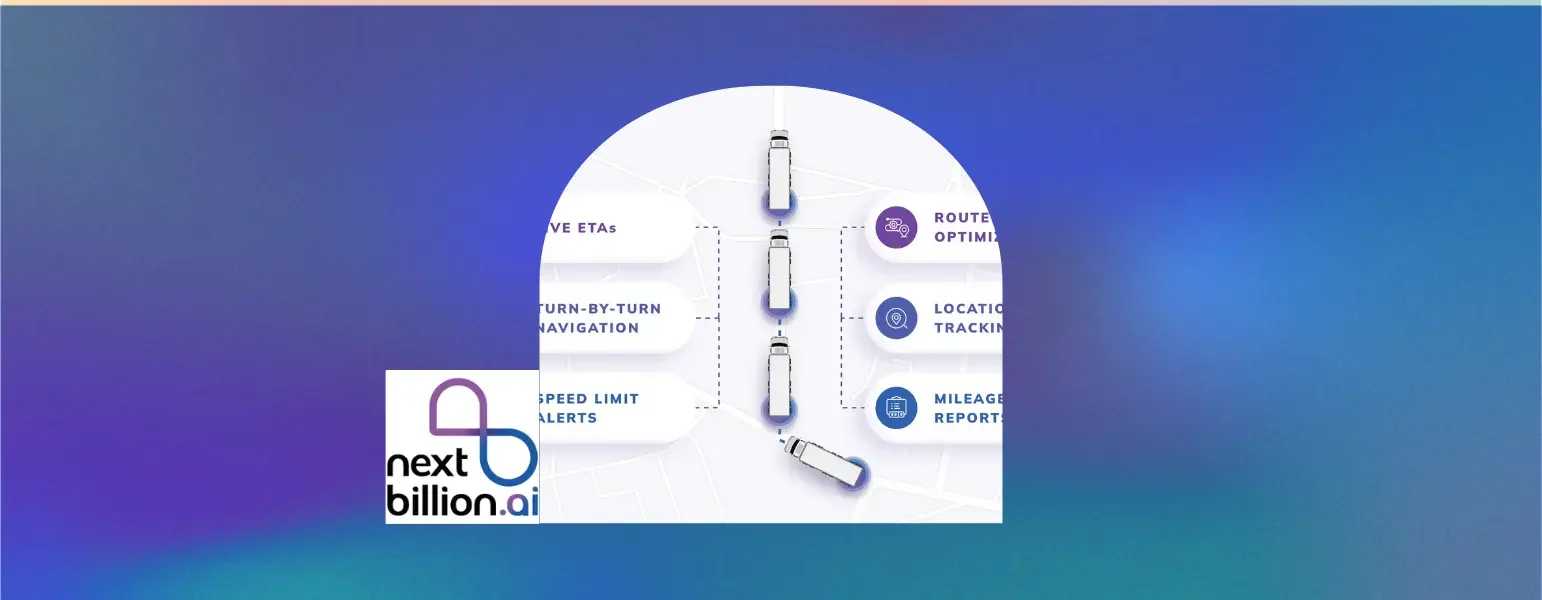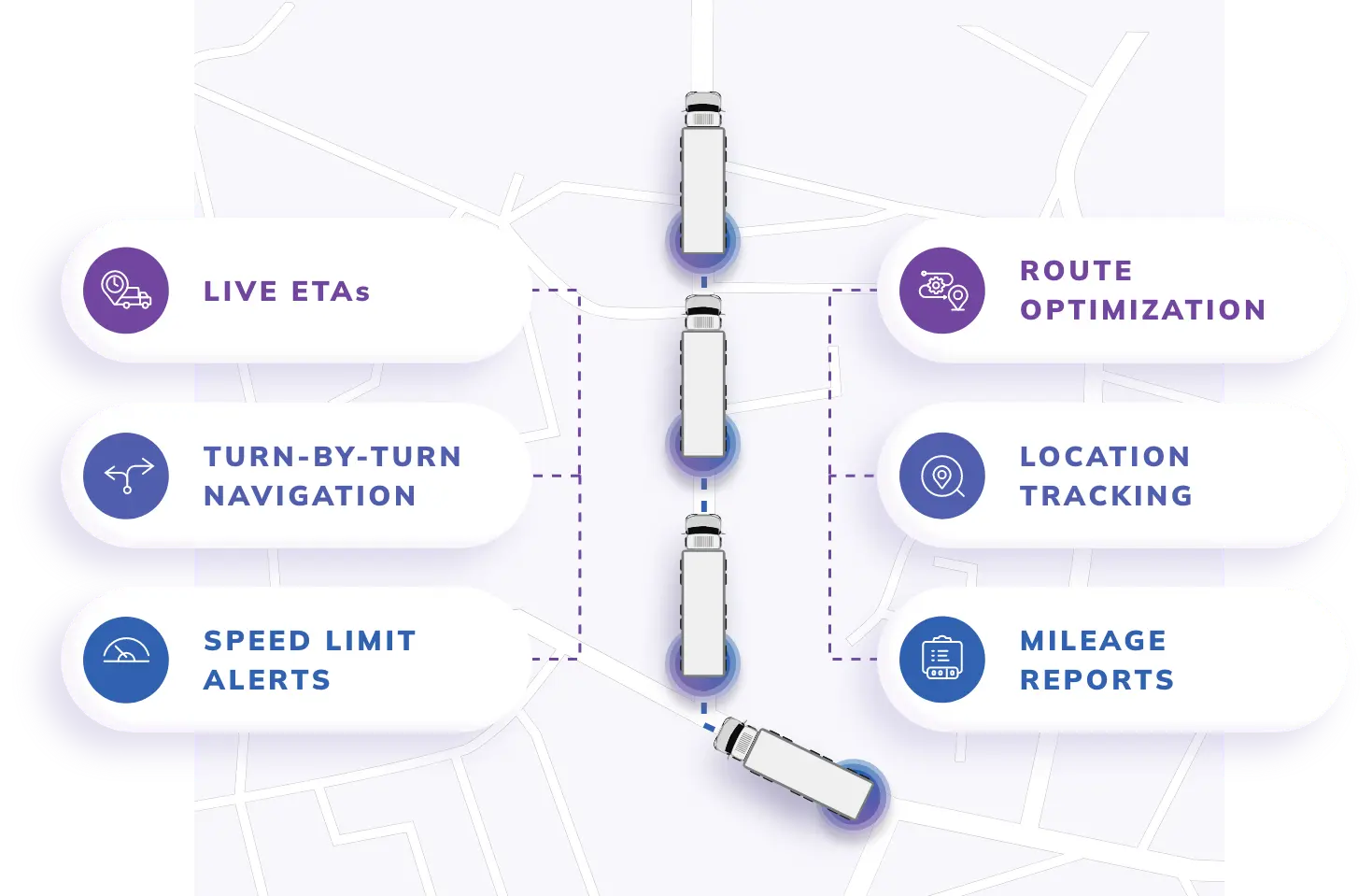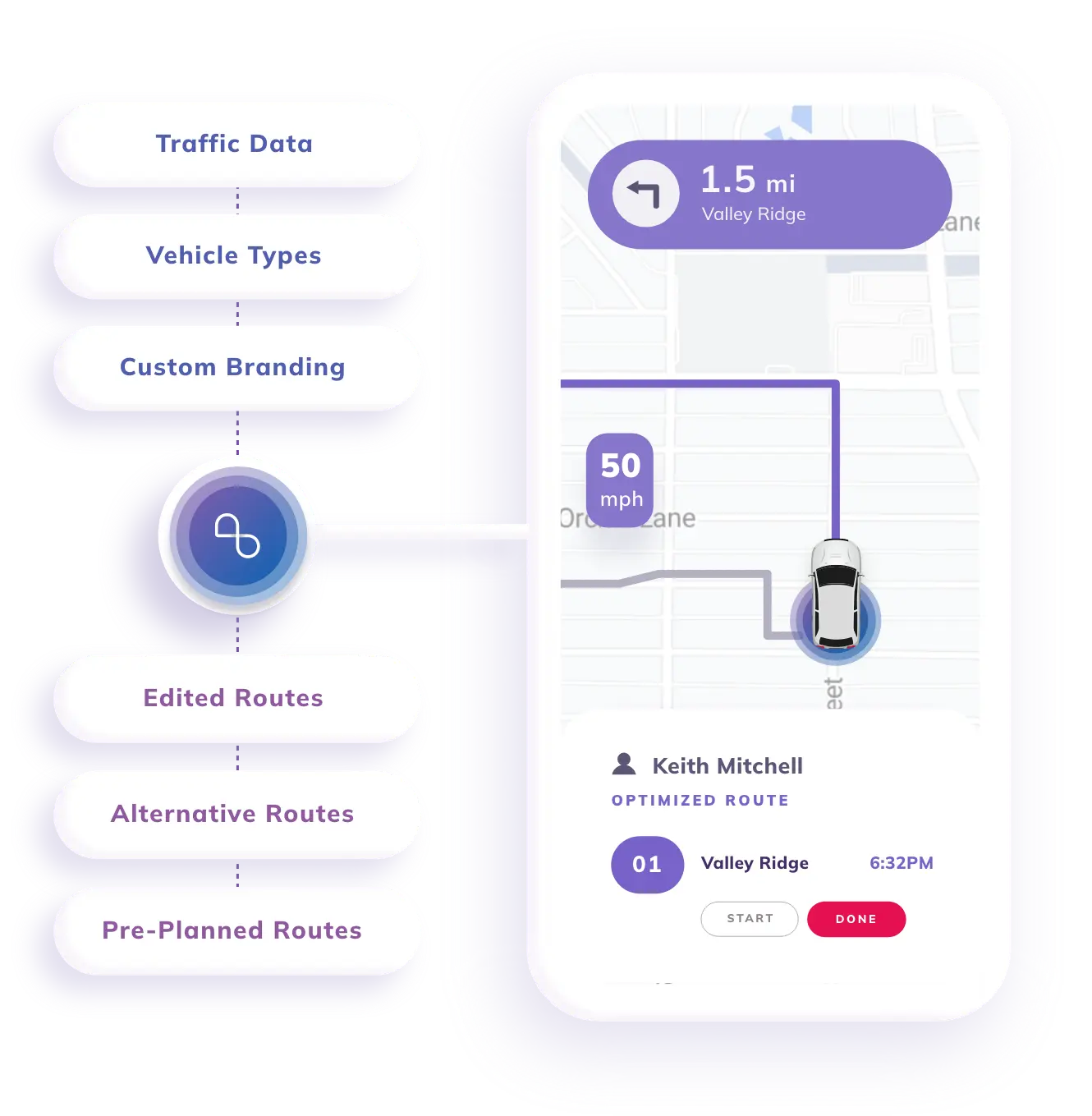

- BLOG
Better Route Planning with Fleet Tracking
Published: March 21, 2025 | Updated: June 30, 2025
Route Optimization API
Optimize routing, task allocation and dispatch
Distance Matrix API
Calculate accurate ETAs, distances and directions
Directions API
Compute routes between two locations
Driver Assignment API
Assign the best driver for every order
Routing & Dispatch App
Plan optimized routes with 50+ Constraints
Product Demos
See NextBillion.ai APIs & SDKs In action
AI Route Optimization
Learns from Your Fleet’s Past Performance
Platform Overview
Learn about how Nextbillion.ai's platform is designed
Road Editor App
Private Routing Preferences For Custom Routing
On-Premise Deployments
Take Full Control of Your Maps and Routing
Trucking
Get regulation-compliant truck routes
Fleet Management
Solve fleet tracking, routing and navigation
Middle Mile Delivery
Optimized supply chain routes
Construction
Routes for Construction Material Delivery
Oil & Gas
Safe & Compliant Routing
Food & Beverage
Plan deliveries of refrigerated goods with regular shipments
Table of Contents

Route planning has played an essential part in fleet optimization. Given the rising cost of fuel and the need to reduce fuel consumption, fleet managers must resort to better route planning. They need routes that are both efficient and cost-effective. Leveraging advanced route optimization algorithms ensures that the most efficient routes are determined dynamically. Vehicle availability and on-time delivery must be guaranteed simultaneously in order to meet customer expectations.
Businesses can achieve these goals by implementing effective fleet tracking to reduce fuel use, increase productivity, and improve customer satisfaction. With a projected value of $21.94 billion in 2022, the global fleet vehicle tracking system market is expected to increase at a compound annual growth rate (CAGR) of 13.2% from 2023 to 2031, reaching $66.96 billion. Real-time data analytics platforms and cloud-based fleet management systems are driving this growth. It is evident from this statistic that there will always be a greater need for fleet tracking solutions.
Fleet tracking networks use GPS tracking, telematics devices, and IoT sensors, providing numerous benefits in better route planning. They can dramatically improve a fleet’s efficiency, safety, as well as overall performance. Advanced features such as driver behavior monitoring through accelerometer sensors and predictive maintenance using diagnostic fault codes (DTCs) help to improve efficiency even further.
Using a fleet optimization and tracking system has indeed become essential to staying competitive as the need for dependable and quick deliveries increases.

In logistics management, route planning is the process of figuring out the most effective way to get from one place to another while accounting for variables like delivery timetables, vehicle type, traffic conditions, and driver availability.
Advanced route planning tools use real-time GPS data and historical traffic patterns to optimize delivery efficiency. The purpose is to optimize routes for faster delivery times, less fuel usage, and higher customer satisfaction. Real-time monitoring provides minute-by-minute location updates and vehicle reports. It monitors and analyzes performance plus journey replay, which allows for retrospective study of routes taken and identifies areas for improvement, are all key components of an effective and better route planning.
As a fleet manager, it is essential to understand that manually planning the routes is more difficult, and automated route planning software can simplify your task. Instead of making decisions intuitively, you can use the software to make routing decisions based on real-time datasets. Let’s understand how route planning software helps fleet managers:
A confused driver who lacks sufficient guidance/information on rerouting or different delivery strategies will increase the company’s delivery costs and can lead to poor customer experience. The most efficient routes, different delivery sites, and real-time route dynamics must all be communicated to the delivery driver. The route planning component in the fleet management system can assess the driver’s skills and assign the routes accordingly.
Dynamic route planning involves adding several stops to the same route to accommodate multiple order deliveries. Real-time traffic and weather conditions can be used to optimize dynamic route planning.
Cloud-based dynamic routing platforms ensure adjustments happen in real-time. Real-time data optimization further reduces time spent on the road, lowering fuel expenses. Route efficiency guarantees on-time deliveries and customer satisfaction.
Delivering orders sequentially to multiple locations within a short time frame can lead to significant inefficiencies and increased costs. These inefficiencies often arise from poorly planned routes. To optimize delivery performance and reduce losses, routes should be strategically planned based on the following factors:
Dedicated route planning can help you save money, time, and energy. For instance, NextBillion.ai’s route optimization generates an optimal route which covers all the deliveries across
Certain businesses require daily travel of more than 200-1000 kilometers. Such lengthy distances can substantially impact the business since they involve fuel expenses, vehicle capacity limits, fleet running costs, travel time, transportation charges, and end-route vehicle wear and tear. Telematics-based maintenance alerts help reduce unexpected breakdowns. Delivery route optimization tools are also required if a company wants to reduce all additional expenditures.
Let’s look at the advantages of fleet vehicle tracking in effective route planning:
Imagine your drivers effortlessly navigating the highways and avoiding traffic. Tracking systems optimize routes and provide real-time information to keep your drivers out of traffic jams and long delays.
What does this mean for your business? It leads to increased delivery time and happier consumers. You will outperform your competitors by a significant margin, leaving them confused as to how you can fulfill deliveries so rapidly.
Vehicle tracking might help you win big in customer fulfillment. With accurate tracking and effective route planning, all the deliveries will be timely aligned and completed accordingly. There will be no more unhappy clients or missed delivery windows. Furthermore, word-of-mouth recommendations will start to flow, leading to increased profits and better productivity.
When it comes to keeping your drivers and expensive fleet secure, GPS fleet tracking has you covered. Driver behavior monitoring solutions allow you to identify risky driving behaviors and take proactive efforts to address them.
Let’s not overlook the protection against theft. Real-time monitoring ensures that you are quickly notified if a vehicle deviates from its intended path or slips into the wrong hands.

A technology system called a Vehicle Tracking System (VTS) is made to track and manage the location and conditions of a fleet of vehicles. A VTS uses GPS and other tracking technologies to collect real-time data on vehicle positions, speeds, and routes. The data is transmitted via secure communication protocols like HTTPS and MQTT. This data is transferred to a central server via cellular or satellite networks, where it is accessible via a user interface.
Businesses can utilize this information to optimize routes, ensure on-time delivery, and improve overall fleet and fuel efficiency. Advanced systems are a complete fleet management solution that goes beyond simple location tracking to offer insights into driver behavior, vehicle condition, and operational patterns. Integration with onboard diagnostics (OBD-II) and CAN bus data allows for detailed vehicle health monitoring.
Here’s how fleet management system plays an essential role in route planning:
Say goodbye to the days of attempting to locate your automobiles with GPS vehicle tracking software. The software’s real-time position updates allow you to track your fleet’s precise location on a map. Geospatial mapping technologies like GIS (Geographic Information Systems) provide highly accurate location data.
Real-time fleet tracking puts you in control of your assets, whether you’re organizing deliveries, responding to emergencies, or simply keeping track of them.
Getting real-time performance analytics allows you to detect performance gaps and take proactive steps to close them. These analytics are often powered by advanced data visualization tools such as Power BI or Tableau.
Thorough analytics and reporting are another essential element of fleet management software in better route planning. Using measures like fuel usage, average speed, idle times, and adherence to planned routes, this software provides information about the performance of the fleet as well as individual drivers. Reports can be automatically generated and exported in formats like CSV, PDF, and Excel for further analysis.
Fleet managers can use this data to discover areas for improvement, make educated route adjustments, and optimize overall fleet performance. Furthermore, this information can be utilized to improve driver training programs, with a focus on aspects such as fuel efficiency and safety. Machine learning models can identify patterns in driver behavior and suggest personalized training programs.
The ability to interact with other systems is critical for comprehensive fleet management software and solutions. API connectivity allows enterprise resource planning (ERP), inventory management, and customer relationship management (CRM) systems to easily interact with route planning systems. APIs using RESTful architecture ensure seamless data exchange across platforms.
This interoperability guarantees that all essential departments have access to current information, allowing for enhanced collaboration and efficiency across the business. For example, integrating with a CRM system can provide consumers with real-time delivery updates, increasing their pleasure and trust in the company’s services. Webhook-based notifications allow instant updates between systems without manual intervention.
When selecting a vehicle tracking system for your company, it’s critical to comprehend the available different types:
Satellite GPS Tracking
Satellite GPS tracking provides precise global coverage. It is perfect for enterprises operating in remote or international areas where cellular service is limited. Systems like Iridium, Inmarsat, and Globalstar offer continuous tracking capabilities.
Cellular-Based Tracking
Cellular tracking transmits data over mobile networks. It is useful in metropolitan areas with adequate network coverage and is usually less expensive than satellite tracking. It supports 4G LTE and 5G connectivity for high-speed data transmission.
Radio Frequency Identification (RFID)
RFID technologies are useful for short-range tracking and access control. They are frequently employed in areas where exact position tracking is not required, but monitoring entry and departure points is critical. Passive and active RFID tags provide different levels of tracking accuracy.
Telematics Systems
Telematics is a combination of GPS tracking and vehicle diagnostics. These systems can track a variety of vehicle data, including fuel efficiency, engine performance, and driver behavior. Telematics solutions offer a full perspective of fleet operations, making them ideal for large fleets with complicated needs. They integrate with OBD-II ports and CAN bus systems to provide real-time diagnostic data.
Understanding how exactly GPS fleet tracking works can be difficult, but we are here to help make it less complicated. Essentially, your fleet tracking system will use a combination of hardware, servers, and software that works in the following ways:

With the integration of NextBillion.ai on the Motive marketplace, fleet managers, drivers, and administrators now have access to advanced tools for optimal route planning. This partnership empowers businesses to enhance efficiency by using streamlined route planning software for vehicle monitoring.
NextBillion.ai proposes a suite of solutions, including the Live Monitoring API, Asset Tracking SDKs, and the Live Tracking UI Tool. These tools provide comprehensive tracking capabilities that can be customized to meet your business’s specific needs. Supporting RESTful architecture and delivering data in JSON format, these APIs ensure seamless integration with existing systems.
Together, these solutions enable efficient, accurate, and dynamic fleet operations. Let us break down the most prominent features:
The Live Tracking UI constantly updates each asset’s location to give fleet managers the most up-to-date information. This functionality is essential for dynamic contexts in which vehicle positions change often. The tool uses high-frequency data polling and real-time GPS data streams to minimize latency.
Assets are identified by status indicators that display their present state, such as moving, idle, or halted. These indications allow managers to analyze the situation and make required changes. Color-coded indicators and state-change algorithms ensure real-time accuracy.
In addition to real-time monitoring, users can review their asset’s prior movements and activity. This capacity is useful for studying trends, optimizing routes, and detecting anomalies in asset utilization. Historical data is stored in cloud-based databases and can be queried using SQL or NoSQL systems for comprehensive analysis.
Once configured, alerts are provided in real-time via the UI, email, or SMS. This instant notification system allows fleet managers to react quickly to problems or changes in asset status. Notifications are delivered via integration with services like Twilio, Firebase, or custom APIs.
Users can establish monitors to track certain assets or asset groups continuously. Monitors can be configured to focus on specific routes, zones, or categories of activity, delivering targeted oversight where it is most required. Rule-based triggers and geofencing logic allow for precise monitoring of asset activities.
The user interface allows you to easily set up geofences, which are virtual borders surrounding certain geographic areas. The system generates an alert whenever an asset enters or quits a geofenced area. This function is especially important for tracking compliance with specified routes and ensuring that assets stay in allowed zones. Geofencing technology uses polygon-based geospatial data models and proximity detection algorithms to enhance accuracy.

The future of route optimization promises continuing innovation and transformation, propelled by technological improvements, altering market dynamics, and changing client expectations. Here’s what to expect:
AI-powered algorithms that enable more precise forecasts, flexible routing plans, and proactive decision-making based on current data and past patterns will greatly improve route optimization. Deep learning models like convolutional neural networks (CNNs) analyze vast datasets to improve route efficiency.
The development of self-driving cars and drones will revolutionize route optimization, creating new opportunities for last-mile deliveries, greater flexibility, and cheaper operational costs. LIDAR (Light Detection and Ranging), radar systems, and computer vision algorithms enable autonomous navigation and obstacle detection.
For supply chains to be more smooth and effective, route optimization will include a variety of transportation methods, including trucks, trains, ships, and planes.
Future route optimization systems will be more dynamic and predictive, constantly altering routes in response to changing conditions such as traffic congestion, weather delays, and client demand. Predictive analytics powered by machine learning models will anticipate future challenges and opportunities, allowing companies to plan routes ahead of time.
Effective routing stands out as an important distinction impacting all operational aspects in a dynamic market with rising customer expectations and intense competition. Additionally, it has a direct impact on the consumer experience. With inventive technologies such as NextBillion AI’s APIs, SDKs, and AI-driven routing solutions, you can join a group of organizations that are significantly improving client satisfaction while increasing operational efficiency. Consult with our experts to fully realize the possibilities of your fleet routing operations.
Here are the key fleet management trends for 2025:
Autonomous vehicle technology is becoming a reality for fleet management and is no longer a futuristic technology. Innovative features, including adaptive cruise control, automated lane-keeping, and collision avoidance, are widely adopted.
One of the most visible developments in fleet management and better route planning is the move toward electrification. With a strong focus on lowering carbon emissions and encouraging sustainability, an increasing number of corporations are investing in electric vehicles for their fleets.
Bhavisha Bhatia is a Computer Science graduate with a passion for writing technical blogs that make complex technical concepts engaging and easy to understand. She is intrigued by the technological developments shaping the course of the world and the beautiful nature around us.